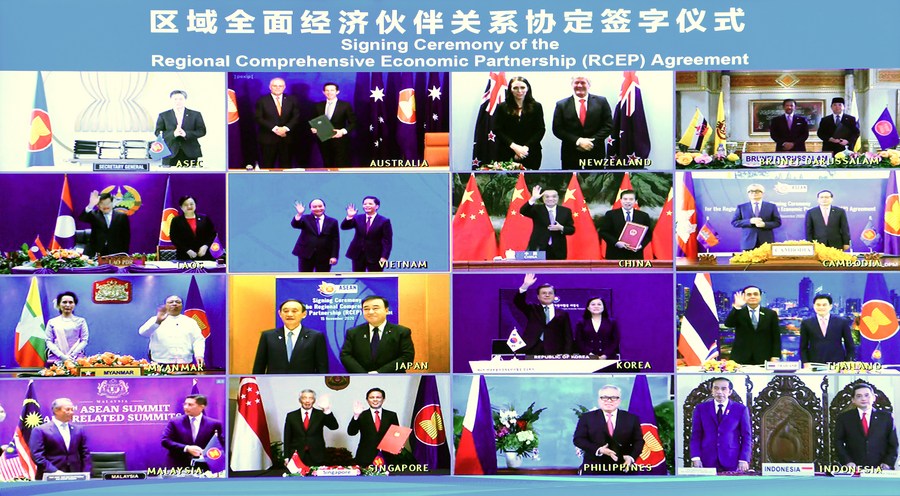Landmark RCEP trade pact to boost regional economic integration


BEIJING -- The signing of the Regional Comprehensive Economic Partnership (RCEP), the world's biggest trade pact, marks a new stride toward regional economic integration among Asia-Pacific countries.
After 31 rounds of negotiations over eight years, the trade agreement between 10 members of the Association of Southeast Asian Nations, China, Japan, the Republic of Korea (ROK), Australia and New Zealand was signed on Sunday.
Hailed as "a victory of multilateralism and free trade," the pact will vigorously boost confidence in regional trade and investment, reinforce the industrial and supply chains, hasten the economic recovery and promote the long-term prosperity of the region.
The RCEP integrates existing free-trade partnerships among participating countries, while establishing new ones between China and Japan, and between Japan and the ROK, China's Ministry of Commerce (MOC) said in a series of articles explaining the trade agreement on its website.
The pact optimizes economic and trade rules among signatories, streamlining procedures to facilitate cross-border logistics and introducing negative lists to promote investment liberalization, the MOC said.
More economic and technological assistance will be provided for the developing and least-developed economies in the region after the RCEP comes into force, as part of efforts to promote regional coordinated development, according to the ministry.
Specifically, RCEP signatories will promote opening-up in trade in goods and services, investment and personnel exchange.
After the pact takes effect, more than 90 percent of the import tariffs between participating countries will be phased out, which will reduce production costs and commodity prices, bringing benefits to both enterprises and consumers, said the MOC.
The 15 signatories have all pledged wider opening-up in the services-trade sector, focusing on areas including health care, real estate, finance and transportation.
Meanwhile, business people will be able to obtain visas more conveniently from RCEP countries, further facilitating trade and investment, said the MOC.
Cao Jing, deputy secretary-general of the Trilateral Cooperation Secretariat, which consists of China, Japan and the ROK, said the signing of the RCEP will lead to robust growth of trade and investment in participating countries as it represents higher-level opening-up, a larger market and better policies.
Covering a market of 2.27 billion people and a combined GDP of $26.2 trillion, the RCEP signatories, which account for about one third of the world's economy, will become a large integrated market, thus injecting impetus into regional and global economic growth, the MOC said.
The RCEP will also reduce the current "obstructions" in the global industrial chains and supply chains, and accelerate post-pandemic economic recovery, according to Cao.
Signed at a time when a coronavirus-triggered recession looms large globally, the RCEP shines rays of hope through the dark clouds of global trade uncertainty, proving to the world that openness and cooperation are a sure path toward common prosperity.
The signing of the RCEP is crucial and timely, said Ruan Zongze, executive vice president of the China Institute of International Studies, adding that the RCEP agreement represents a victory for multilateralism over unilateralism and free trade over protectionism.
It accommodates the broadest possible interests, conditions and priorities and sends a clear message of East Asian countries working together for shared prosperity, said Ruan.




































